First Aid Training Programme
A first aid training program is a structured educational course designed to equip individuals with the knowledge, skills, and confidence to provide immediate assistance and care to someone who is injured or becomes ill before professional medical help arrives. These programs are typically conducted by certified instructors, such as healthcare professionals or experienced first aid trainers.
Duration
The program is usually conducted over a period of 30 min to 1 hour, depending on the level of training and the specific curriculum.
Overall, a first aid training program aims to empower individuals with the necessary skills and knowledge to respond effectively in emergency situations, potentially saving lives and minimizing the impact of injuries or medical emergencies until professional medical assistance can be obtained.

Target Audience
The training program is open to individuals from various backgrounds, including but not limited to employees in the workplace, teachers, parents, caregivers, sports coaches, and community members.
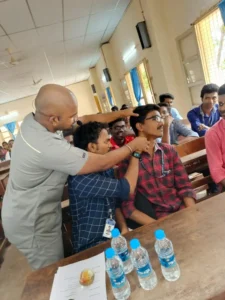
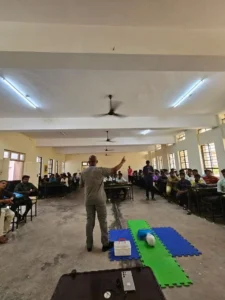
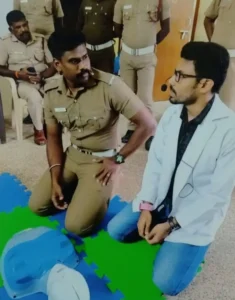


Overall, a first aid training program aims to empower individuals with the necessary skills and knowledge to respond effectively in emergency situations, potentially saving lives and minimizing the impact of injuries or medical emergencies until professional medical assistance can be obtained.
Course Objectives
- To develop a basic understanding of the principles of first aid.
- To familiarise participants with common injuries and medical emergencies.
- To teach participants how to assess and prioritise a situation to provide appropriate care.
- To demonstrate proper techniques for administering first aid, including CPR (Cardiopulmonary Resuscitation), bandaging, splinting, and wound care.
- To educate participants on recognizing signs of serious conditions and knowing when to seek professional medical help.
- To promote safety awareness and accident prevention strategies.
Overall, a first aid training program aims to empower individuals with the necessary skills and knowledge to respond effectively in emergency situations, potentially saving lives and minimizing the impact of injuries or medical emergencies until professional medical assistance can be obtained.
Curriculum and Training Components
Introduction to First Aid : Overview of the importance of first aid, legal considerations, and the role of a first aider.
Basic Life Support (BLS) : Instruction on CPR, including chest compressions and rescue breaths, for adults, children, and infants. Airway Management: Techniques for clearing airways and preventing choking.
Bleeding Control and Shock Management : Instruction on controlling bleeding, applying pressure dressings, and recognizing and treating shock.
Fractures, Sprains, and Strains : Assessment, stabilisation, and immobilisation techniques for musculoskeletal injuries.
Medical Emergencies : Recognition and initial management of conditions such as heart attacks, strokes, seizures, allergic reactions, and diabetic emergencies.
Environmental Emergencies : Identification and response to heat stroke, hypothermia, and poisoning.
Practical Skills : Hands-on practice sessions to reinforce the learning objectives, including bandaging, splinting, and scenario-based simulations.
Review and Assessment : Recapitulation of key concepts and a final assessment to evaluate participants’ understanding and proficiency.
Overall, a first aid training program aims to empower individuals with the necessary skills and knowledge to respond effectively in emergency situations, potentially saving lives and minimizing the impact of injuries or medical emergencies until professional medical assistance can be obtained.
Training Materials and Resources
Participants are provided with comprehensive training manuals, visual aids (such as videos and diagrams), and practical equipment (such as CPR manikins, bandages, and splints) to facilitate hands-on learning.
Overall, a first aid training program aims to empower individuals with the necessary skills and knowledge to respond effectively in emergency situations, potentially saving lives and minimizing the impact of injuries or medical emergencies until professional medical assistance can be obtained.

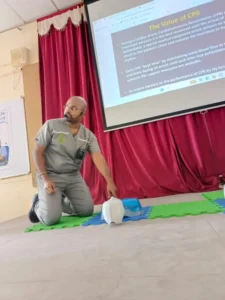
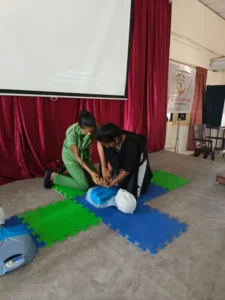
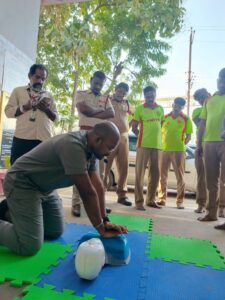

Certification
Upon successful completion of the training program, participants may receive a first aid certification, which is valid for a specified period (usually 2-3 years). The certification demonstrates the individual’s competence in providing first aid and may be required for certain job roles or volunteer positions.
Overall, a first aid training program aims to empower individuals with the necessary skills and knowledge to respond effectively in emergency situations, potentially saving lives and minimizing the impact of injuries or medical emergencies until professional medical assistance can be obtained.
Let's make a better world Join your hands with us
Come and join us in our pursuit to make a positive impact on the world, and enhance the quality of life for the individuals who need it the most. With your support, we can make affordable healthcare a reality for everyone!
